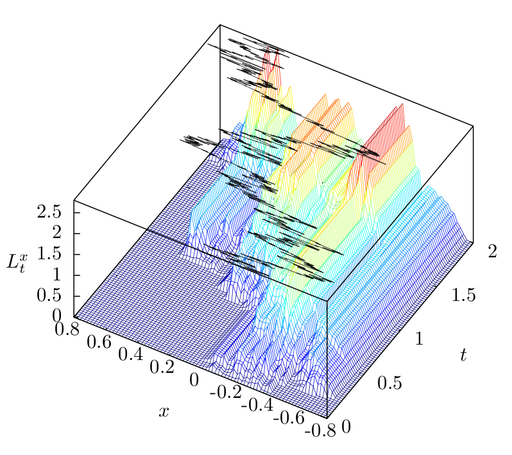Advanced Statistical Physics
Statistical physics describes systems with many interacting degrees of
freedom. Tools and concepts of statistical physics have applications
in condensed matter physics, but also far beyond the traditional realm of physics, for instance in the modeling of biological, economic,
or social systems. This lecture course covers the basic tools of modern statistical physics, as well as the required mathematical apparatus.
A key concept to address fluctuations on different length-scales is the so-called renormalisation group, which emerges as the shared language between
quantum field theory, condensed matter physics, statistical physics, and even cosmology. Particular topics are
in condensed matter physics, but also far beyond the traditional realm of physics, for instance in the modeling of biological, economic,
or social systems. This lecture course covers the basic tools of modern statistical physics, as well as the required mathematical apparatus.
A key concept to address fluctuations on different length-scales is the so-called renormalisation group, which emerges as the shared language between
quantum field theory, condensed matter physics, statistical physics, and even cosmology. Particular topics are
- stochastic systems: equilibration and the Boltzmann measure
- lattice models: exactly solvable systems in one and two dimensions; high- and low-temperature expansions; dualities
- the renormalisation group and scaling
- Landau-Ginzburg theory and fluctuations: introduction to the field-theoretic approach
- disordered systems
Schedule
Lectures are on Tuesdays 8:00-09:30 and Thursdays 10:00-11:30 in lecture
theater III;
the first lecture is on October 10th, 8:00
Exercises: Please see the separate page here.
Exam: Lecture theatre I, 6.02.2018 at 13:00
Retake: Lecture theatre I, 26.3.2018 at 12:30
Exercises: Please see the separate page here.
Exam: Lecture theatre I, 6.02.2018 at 13:00
Retake: Lecture theatre I, 26.3.2018 at 12:30
Teaching material
Here, you find Mathematica notebooks on some
analytically solvable models addressed in this course, as well as
links to applets
and other material of interest. To view the results you can use the free Wolfram CDF Player (500Mb, sorry!). To explore the solutions
further on your own, you can use the Mathematica notebooks (.nb) on the computers in the CIP-lab, which run Mathematica.
Ising model in 1D .cdf .nb .pdf
Ising model in 2D .cdf .nb .pdf
Weiss' model of the ferromagnet .cdf .nb .pdf
Dominik Derigs (thanks!) has produced an animation of the free energy function of the Curie-Weiss (mean field) ferromagnet, available here.
Watch the parameters beta and h in the bottom right corner.
There are many applets simulating the 2D-Ising model. This one here lets you change both the temperature and the magnetic field (try it!).
This fabulous video by D. Ashton showcases the key idea of the renormalisation group.
A handout covering the RG analysis of the Landau-Ginzburg action for the coupling parameter g is available here.
You are most welcome participate in an online survey to identify ways to improve teaching in statistical mechanics. The link is here.
and other material of interest. To view the results you can use the free Wolfram CDF Player (500Mb, sorry!). To explore the solutions
further on your own, you can use the Mathematica notebooks (.nb) on the computers in the CIP-lab, which run Mathematica.
Ising model in 1D .cdf .nb .pdf
Ising model in 2D .cdf .nb .pdf
Weiss' model of the ferromagnet .cdf .nb .pdf
Dominik Derigs (thanks!) has produced an animation of the free energy function of the Curie-Weiss (mean field) ferromagnet, available here.
Watch the parameters beta and h in the bottom right corner.
There are many applets simulating the 2D-Ising model. This one here lets you change both the temperature and the magnetic field (try it!).
This fabulous video by D. Ashton showcases the key idea of the renormalisation group.
A handout covering the RG analysis of the Landau-Ginzburg action for the coupling parameter g is available here.
You are most welcome participate in an online survey to identify ways to improve teaching in statistical mechanics. The link is here.
Literature
N. Goldenfeld, Lectures on phase transitions and the renormalization
group, Westview Press
N.G. van Kampen, Stochastic Processes in Physics and Chemistry, North Holland
M. Kardar, Statistical Physics of Fields, Cambridge University Press
M. Plischke and B. Bergersen, Equilibrium Statistical Physics, World Scientific
(in German) H. Römer and T. Fink, Statistische Mechanik, VCH
The best single book to start with is Kardar. This is the second volume of two. You may also want to look at the first volume
(Statistical Physics of Particles) to refresh your knowledge of elementary statistical physics. The topics of scaling and renormalisation are covered optimally in Goldenfeld.
N.G. van Kampen, Stochastic Processes in Physics and Chemistry, North Holland
M. Kardar, Statistical Physics of Fields, Cambridge University Press
M. Plischke and B. Bergersen, Equilibrium Statistical Physics, World Scientific
(in German) H. Römer and T. Fink, Statistische Mechanik, VCH
The best single book to start with is Kardar. This is the second volume of two. You may also want to look at the first volume
(Statistical Physics of Particles) to refresh your knowledge of elementary statistical physics. The topics of scaling and renormalisation are covered optimally in Goldenfeld.
The picture above shows a sample path of a random walk. It was created by Roboquant, see here for details and licensing.
